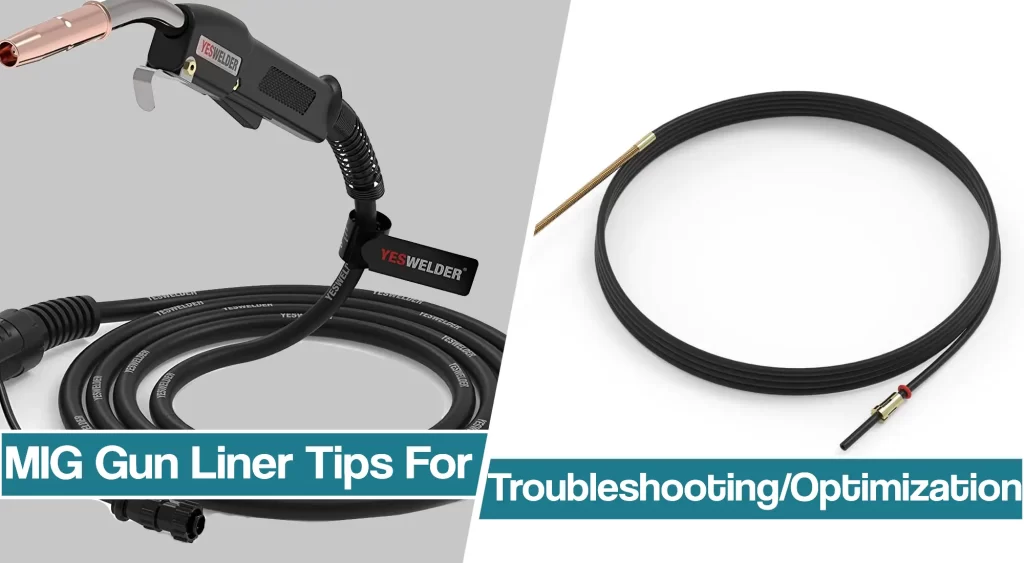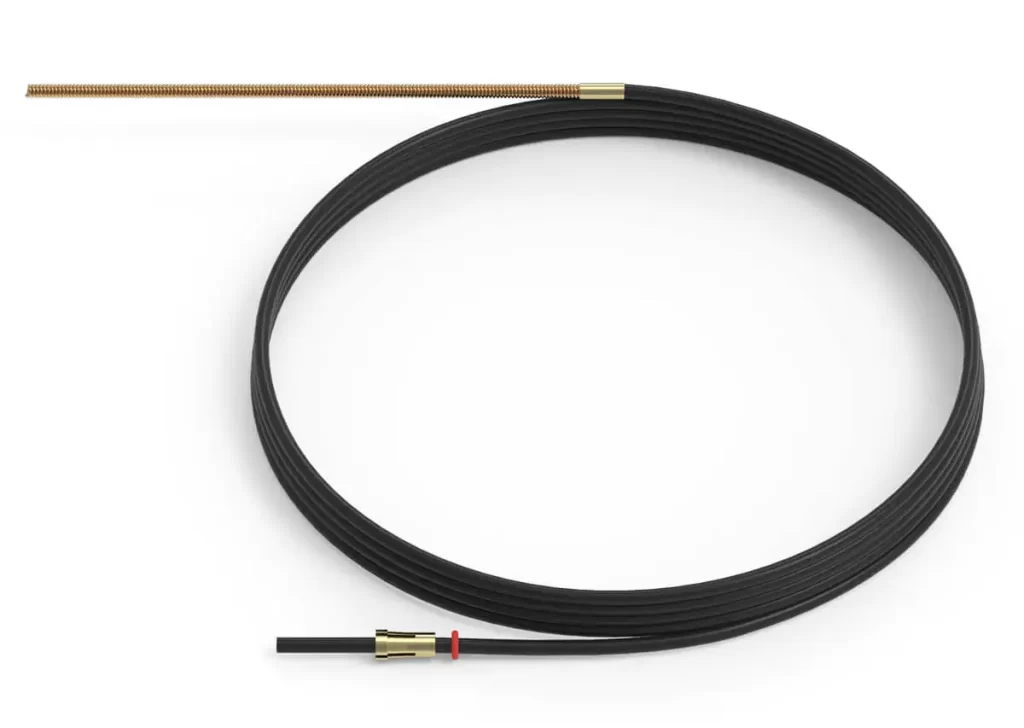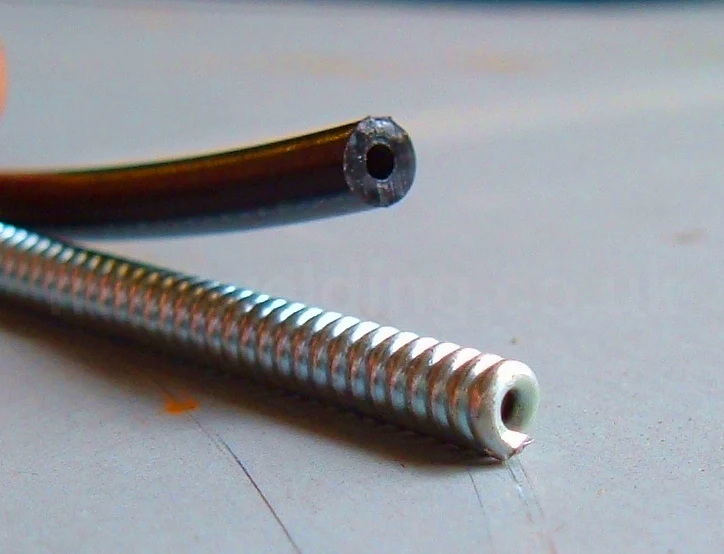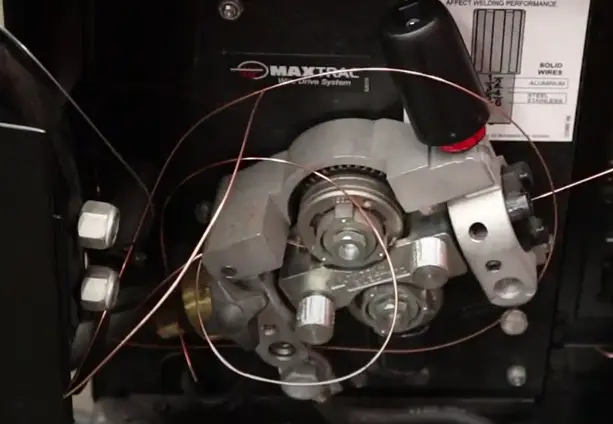A MIG gun liner is one of the simplest as well as most important components of a welding gun.
Its only purpose is guiding the welding wire from the wire feeder, through the gun cable, and into the contact tip. But, if a liner is not performing its task properly, the gun is completely useless.

Numerous issues can oppose the liner’s ability to guide the wire through the welding cable as intended. If the wire isn’t fed correctly, the resulting weld quality issues lead to increased operator downtime and costly rework. This creates unnecessary costs for you and your shop.
These tips will help welders get the best performance from a MIG gun liner and troubleshoot problems when they occur.
Optimizing MIG Liner Performance
The old saying that “prevention is the best medicine” still holds true with MIG gun liners. Maintaining your MIG gun liners proactively eliminates problems before they occur, reducing operator downtime, more severe equipment failures, and costly rework.
Choose the Adequate Size
To maximize the potential of your MIG welding equipment, use the adequate liner size for the MIG wire you’re using.
Small-diameter welding wires, 0.023- through 0.045-inch, have pretty low column strength. So, using these wires with an oversized liner causes the wire to wander or drift inside the liner.
As a result, this leads to poor wire feeding and excessive liner wear. The wire shouldn’t be too loose inside the liner because it will hit the liner’s walls harshly and ravel inconsistently.

However, larger-diameter welding wires, 1/16- through 1/8-inch, have far higher column strength. So, they won’t experience the same issues as with an oversized liner.
You should always check what is the recommended wire diameter with the MIG gun liner you are using. Some welding brands don’t provide this information, which is unfortunate. But that’s the difference between poor import brands whose manufacturers aren’t even aware of this issue, and high-quality brands that provide every specification there is.
Liner quality
The liner quality also impacts welding performance, productivity, and operator downtime. A premium liner is consistent inside throughout its length. There are no variations in diameter or inside surface of the liner.
This is crucial because variances as small as a few thousandths of an inch resulting in wire feeding issues requiring time-consuming liner replacement.
Many MIG gun manufacturers purchase their liners from a small group of liner manufacturers. Other companies manufacture their liners in-house, which allows quality control throughout the manufacturing process.
Don’t Bend The MIG Gun Cable Harshly
Most MIG gun liners are made from coiled steel wire, which gives the liner its distinct rigidity and flexibility and allows it to guide the welding wire through a tightly bent cable without kinking. This wire type is also sometimes called music or piano wire, and it’s highly flexible. Nevertheless, bending the MIG gun lead too harshly can cause poor wire feeding, premature liner wear, and “bird nesting” in the wire feeding unit.
Proper Liner Installation To Avoid Birdnesting
If you install the liner incorrectly, you can experience wire feeding problems, such as bird’s nesting.
Trimming the liner to adequate length may sound like a simple task, but frequently MIG gun cables are wound in a helix pattern, which causes them to shrink or grow when twisted.
This is an often-overlooked fact that requires additional precaution, especially if you’ve never installed a MIG gun liner before.

If you trim the liner with a twisted MIG gun liner, the resulting liner may be too short when the cable is untwisted. The gaps between the gas diffuser (contact tip) of the MIG gun and the end of the liner can make wire feeding difficult, which can result in erratic wire feed or bird nesting.
Some manufacturers print markings on the outside of the weld cable to show when the cable is twisted, allowing for more accurate trimming. If your gun does not have these markings, make sure the cable is fully extended when inserting the new liner.
Regular Liner Maintenance
Tight MIG gun lead bends increase friction between the liner and the welding wire. This friction makes pushing the wire through the liner more difficult and causes premature wear and small steel wire fragments to accumulate within the liner.
Eventually, these tiny particles can build up and create severe wire feed blockages. But, the same phenomenon occurs to a lesser degree with cables that are only bent slightly, so it’s a good idea to clear out the liner from time to time with compressed air.
MIG Gun Liner Troubleshooting
If you are experiencing a drop in amperage, frequent contact tips burning, or erratic wire feeding, your liner is likely suffering from some of the issues we’ll discuss below.
But, replacing MIG gun liners takes time and more effort, so this is the last thing people check when troubleshooting. However, there are far more issues that arise from other improper welding equipment use or poor welding techniques. You can read our entire guide on arc weld troubleshooting here.
Inadequate Wire Feeding
If the liner is worn out or too much debris builds up inside it, you’ll experience erratic or poor wire feeding. The worn-out liner must be replaced; there is nothing else you can do to improve its condition. Usually, the biggest concentration of wear happens around the neck tube of the MIG gun.
However, if your liner is just overloaded with debris, you can fix this issue promptly. Just use a shop compressor to blow through the liner. Don’t remove the liner from the cable when using compressed air because it’s easier to blow through it; the MIG gun lead provides rigidity.
Changing the liner is a time-consuming process that requires disconnecting the gun from the wire feeder, disassembling the power pin, replacing the old liner, and trimming the new one to fit the gun.
So, some MIG gun manufacturers sell replacement neck liners that allow you to replace only the part of the liner traveling the length of the curved neck tube.
These neck liners reduce welders’ downtime by roughly 15 minutes every time when this liner part is replaced. Plus, these neck liners cost roughly one-third of the price of the full liner, which significantly cuts equipment costs. While liners are not expensive, if you run a shop, you’ll be buying a lot of them.
Birdnesting
A tangled mess of wire called “bird nest” or “bird nesting” occurs if the wire’s travel path is obstructed inside the liner, while the wire feeder pushes the wire. There can be other reasons why a bird’s nest can happen but for the purposes of explaining issues with MIG gun liners, let’s just stick to that.
If the liner is trimmed too short, too large, or small for the wire diameter, or if it’s clogged, it can cause the wire to jam inside it and cause bird nesting in the wire feeding unit.

Check out the above notes on a proper liner replacement to learn how birdnesting can result from trimming a liner too short.
Electrical Short
The liner is not meant to carry welding current. There will be a dramatic loss of amperage and voltage at the arc if loose cable connections or a degraded cable make the liner the path of least electrical resistance.
Two common signs that this has happened are a discolored liner and excessive heat build-up along the power cable. The discoloration is caused by heat and indicates weld current is being carried through the liner instead of the gun’s power cable. A degraded cable will require repair or replacement of the gun cable.
Conclusion
The MIG gun liner is not visible during normal welding operations, but that doesn’t mean it can be overlooked as a significant factor in weld quality and productivity. However, just some basic maintenance troubleshooting a malfunctioning liner will help you retain consistent weld quality and optimal productivity in your shop.





